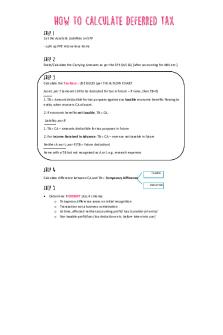ECG - How to read a rhythm strip, how to calculate heart rate & shockable/non-shockable PDF

| Title | ECG - How to read a rhythm strip, how to calculate heart rate & shockable/non-shockable |
|---|---|
| Author | Alyssa Monique |
| Course | Nursing Care 5 - Critical Care |
| Institution | The University of Notre Dame (Australia) |
| Pages | 9 |
| File Size | 532.8 KB |
| File Type | |
| Total Downloads | 31 |
| Total Views | 156 |
Summary
How to read a rhythm strip, how to calculate heart rate & shockable/non-shockable arrhythmias...
Description
ECG’s How to read the ECG? the rhythm strips? 1. 2. 3. 4. 5. 6.
is there any electrical activity? what is the ventricular (QRS) rate? is the QRS rhythm regular or irregular? is the QRS rhythm wide or narrow? is the atrial (P-waves) activity present? what is the relationship between the atrial and ventricle activity (P waves & QRS complex)?
how to calculate heart rate?
method: 1. 2. 3.
use a marked paper to see if it is regular count number of big squares between 2 consecutive R waves divide into 300 (300 squares = 1 minute) eg. 4 squares = 300/4 is 75 beats per minute
mechanics of heart rhythm
Shockable
Rhythms
Ventricular Fibrillation (V-Fib) …
pathophysiology:
causes:
problems in the electrical impulses traveling through your heart after a first heart attack problems resulting from a scar in your hearts muscle tissue from a previous heart attack MI tamponade tension pneumothorax exclude artefact = movement/electrical interference
symptoms:
heart beats with rapid, erratic electrical impulses this results in no cardiac output this causes pumping chambers in your heart (the ventricles) to quiver uselessly instead of pumping blood sometimes triggered by MI, it causes your blood pressure to plummet, cutting off blood supply to your vital organs it is an emergency & requires immediate medical attention most common cause of sudden cardiac death
chest pain rapid heartbeat (tachycardia) dizziness nausea shortness of breath loss of consciousness
treatments:
CPR & defibrillation (SHOCK!) Epinephrine is the first drug given and may be repeated every 3 to 5 minutes if epinephrine is not effective, the next medication in the algorithm is amiodarone 300 mg defibrillation and medication are given in an alternating fashion between cycles of 2 minutes of high-quality CPR
Ventricular Tachycardia (V-T) …
pathophysiology:
abnormally high heart rhythm caused by abnormal electrical signals in the lower chambers of the heart (ventricles) chaotic heartbeats prevent the heart chambers from properly filling with blood resulting in heart not able to pump enough blood to your body & lungs may last only a few seconds or can last much longer can cause the heart to stop (sudden cardiac arrest) it is life-threatening medical emergency
causes:
symptoms:
abnormalities of the heart that result in scarring of heart tissue (sometimes called "structural heart disease"), the most common cause is a prior heart attack poor blood flow to the heart muscle due to coronary artery disease congenital heart conditions, including long QT syndrome imbalance of electrolytes necessary for conducting electrical impulses medication side effects & use of drugs (cocaine or meth)
chest pain (angina) rapid heartbeat (tachycardia) dizziness light-headedness shortness of breath feeling as if your heart is racing (palpitations) loss of consciousness fainting cardiac arrest (sudden death)
treatments:
conscious = stimulate the vagus nerve by gagging to reduce HR, stimulate carotid vein & give drugs (adrenaline & amiodarone) unconscious = SHOCK!
Non-Shockable Rhythms Pulseless Electrical Activity (PEA) …
pathophysiology:
cardiac arrest in which the ECG shows a heart rhythm that should produce a pulse but does not there is electrical activity but the heart either
causes:
hypovolemia hypoxia hydrogen ions (acidosis) hyperkalemia or hypokalemia hypoglycemia hypothermia tablets or toxins cardiac tamponade tension pneumothorax thrombosis (e.g., myocardial infarction, pulmonary embolism) tachycardia trauma (e.g. hypovolemia from blood loss)
symptoms:
loss of consciousness stop breathing spontaneously faint to no pulse
treatments:
CPR (maintain cardiac output until PEA can be corrected) treat underlying cause (eg. relieving a tension pneumothorax) epinephrine (adrenaline) 1mg every 3-5 minutes
Asystole …
pa th op hy sio log y:
causes:
absence of ventricular contractions in the context of a lethal heart arrhythmia most lethal rhythm as it can cause cardiac arrest which is usually irreversible referred to as cardiac flatline, asystole is the state of total cessation of electrical activity from the heart, which means no tissue contraction from the heart muscle and therefore no blood flow to the rest of the body
Hypovolemia Hypoxia Hydrogen ions (acidosis) Hypothermia Hyperkalemia or Hypokalemia Hypoglycemia Tablets or Toxins (drug overdose) Electric shock Tachycardia Cardiac Tamponade Tension pneumothorax Thrombosis (myocardial infarction or pulmonary embolism) Trauma (hypovolemia from blood loss)
symptoms:
sudden collapse no pulse no breathing loss of consciousness
treatments:
CPR internal cardiac massage most likely pronounce the patient dead
Atrial Flutter …
pathophysiology:
causes:
coronary heart & heart valve disease cardiomyopathy & congenital heart disease inflammation of the heart (such as myocarditis) high blood pressure another condition, such as lung disease or overactive thyroid
symptoms:
abnormal heart rhythm that starts in the atrial chambers of the heart fast heart rate & is a type of supraventricular tachycardia sudden-onset regular abnormal heart rhythm on ECG caused by a re-entrant rhythm that occurs along the Cavo tricuspid isthmus of the right atrium through atrial flutter can originate in the left atrium initiated by a premature electrical impulse arising in the atria, atrial flutter is propagated due to differences in refractory periods of atrial tissue this creates electrical activity that moves in a localized self-perpetuating loop, which usually lasts about 200 milliseconds for the complete circuit each cycle around the loop, an electric impulse result and propagates through the atria
feeling of the heart beating too fast, too hard or skipping beats chest discomfort difficulty breathing a feeling of stomach dropping light-headedness loss of consciousness
treatments:
cardioversion = electrical pulse ablation = the catheter causes a ridge of scar tissue in the Cavo tricuspid isthmus that crosses path of the circuit
Atrial Fibrillation …
pathophysiology:
causes:
High blood pressure Heart attack Coronary artery disease Abnormal heart valves Heart defects you're born with (congenital) An overactive thyroid gland or other metabolic imbalance Exposure to stimulants, such as medications, caffeine, tobacco or alcohol Sick sinus syndrome — improper functioning of the heart's natural pacemaker Lung diseases Previous heart surgery Viral infections Stress due to surgery, pneumonia or other illnesses Sleep apnea
symptoms:
irregular and often rapid heart rate the hearts two upper chambers (the atria) beat chaotically & irregularly out of coordination with two lower chambers (the ventricles) of the heart
heart palpitations shortness of breath weakness reduced ability to exercise light-headedness dizziness chest pain
treatments:
cardioversion = electrical & cardioversion with drugs medication = amiodarone, digoxin, beta/calcium channel blocker surgical = catheter ablation, maze procedure, AV node ablation
First Degree Heart Block …
pathophysiology:
it is a disease of electrical conduction system of the heart electrical impulses conduct from the cardiac atria to the ventricles through the atrioventricular node (AV node) a PR interval greater than 200 milliseconds
causes:
AV nodal disease
symptoms:
enhanced vagal tone myocarditis acute myocardial infarction electrolyte disturbances medication = beta/calcium channel blockers, cardiac glycosides, cholinesterase inhibitors
unusual tiredness shortness of breath chest pain weakness, dizziness, or fainting unusual drowsiness or confusion pain that gets worse. symptoms that don't get better with treatment, or symptoms that get worse
treatments:
identifying & correcting electrolyte imbalances withholding any offending medications monitor for progression via ECGs cautious when introducing any drug that may slow down conduction atropine possible insertion of a cardiac pacemaker
Second Degree Heart Block …
TYPE I
pathophysiology:
causes:
characterised by an increasing delay of AV nodal conduction until a P wave fails to conduct through the AV node in type 1, the P wave is blocked from initiating a QRS complex, there is an increased delayed in each cycle before the omission PR interval prolongation with each beat until a P wave is not conducted
drugs = beta & calcium channel blockers, digoxin, amiodarone increased vagal tone inferior MI myocarditis following cardiac surgery = mitral valve repair
symptoms:
dizziness fainting the feeling that your heart pauses for a beat trouble breathing or SOB nausea severe tiredness/fatigue
treatments:
without symptoms = no treatment with symptoms = atropine or transvenous pacing cardiac monitoring
TYPE II
pathophysiology:
causes:
in type 2, the P wave is blocked from initiating a QRS complex, there is no such pattern indicates significant conduction disease in this his-purkinje system & is irreversible not subject to autonomic tone or AV blocking medication structural damage to the AV conduction system
ischemic heart disease antiarrhythmic drug effects idiopathic fibrosis of the conduction system valvular calcification or endocarditis trauma to the conduction system infiltrative cardiomyopathies collagen vascular diseases infectious or inflammatory diseases metabolic & endocrine neutrally mediated tumours that infiltrate the heart neuromuscular diseases congenital heart disease
symptoms:
hypotension syncope or near-syncope new or worsening heart failure dyspnoea angina
ventricular tachycardia (due to long q–t) change in mental status worsening renal function fatigue, or decrease in exercise tolerance
treatments:
with symptoms = atropine or transvenous pacing/cardiac monitor
Third Degree Heart Block …
pathophysiology:
causes:
coronary ischemia 1st & 2nd degree heart block acute MI congenital heart disease hyperkalaemia Lyme disease fibrosis in cardiac conduction system post-cardiac surgery medication vagal tone electrolyte disturbances
symptoms:
a medical condition in which the nerve impulse generated in the sinoatrial node (SA node) in the atrium of the heart cannot propagate to the ventricles the impulse is blocked, an accessory pacemaker in the lower chambers will typically activate the ventricles also activates independently of the impulse generated at the SA node, two independent rhythms can be noted on the ECG P waves with a regular P to P interval (sinus rhythm) represent the first rhythm QRS complexes with a regular R to R interval will be variable lack of any apparent relationship between P waves & QRS
dizziness fainting shortness of breath
treatments:
pacemaker = sedation (midazolam) temporary pacing & revascularisation treat underlying issues (ie. hyperkalaemia)...
Similar Free PDFs

How to Calculate Beta
- 2 Pages

HOW TO READ Ethnography
- 2 Pages

How to Calculate Deferred Tax
- 3 Pages

How to Calculate GST in a Flash
- 2 Pages

How to Calculate your GPA
- 1 Pages

James Monaco - How To Read A Film
- 667 Pages

How to read like a writer
- 3 Pages

Geekymedics.com-How to Read a CTG
- 11 Pages

How to read a paper (Esp)
- 5 Pages
Popular Institutions
- Tinajero National High School - Annex
- Politeknik Caltex Riau
- Yokohama City University
- SGT University
- University of Al-Qadisiyah
- Divine Word College of Vigan
- Techniek College Rotterdam
- Universidade de Santiago
- Universiti Teknologi MARA Cawangan Johor Kampus Pasir Gudang
- Poltekkes Kemenkes Yogyakarta
- Baguio City National High School
- Colegio san marcos
- preparatoria uno
- Centro de Bachillerato Tecnológico Industrial y de Servicios No. 107
- Dalian Maritime University
- Quang Trung Secondary School
- Colegio Tecnológico en Informática
- Corporación Regional de Educación Superior
- Grupo CEDVA
- Dar Al Uloom University
- Centro de Estudios Preuniversitarios de la Universidad Nacional de Ingeniería
- 上智大学
- Aakash International School, Nuna Majara
- San Felipe Neri Catholic School
- Kang Chiao International School - New Taipei City
- Misamis Occidental National High School
- Institución Educativa Escuela Normal Juan Ladrilleros
- Kolehiyo ng Pantukan
- Batanes State College
- Instituto Continental
- Sekolah Menengah Kejuruan Kesehatan Kaltara (Tarakan)
- Colegio de La Inmaculada Concepcion - Cebu






